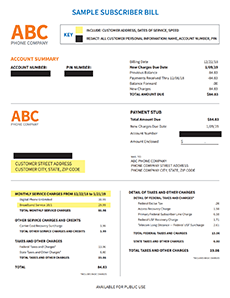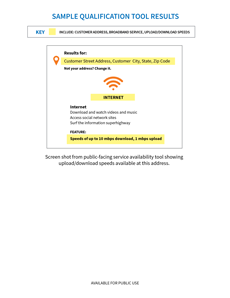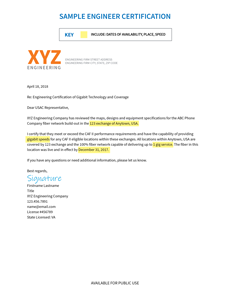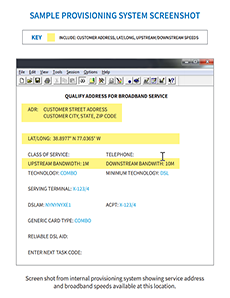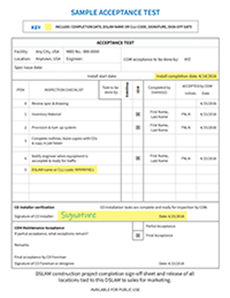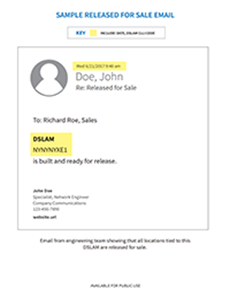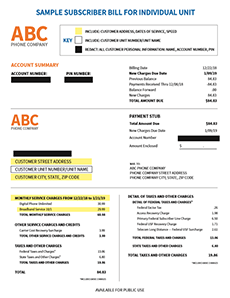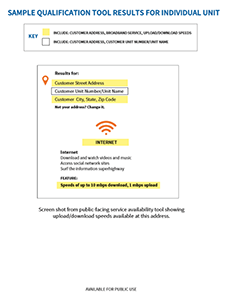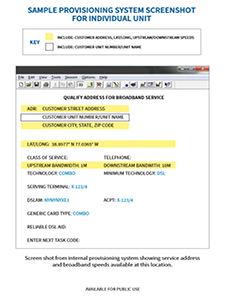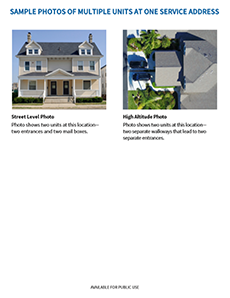Deployment Verification Reviews
The Connect America Fund (CAF) aims to close the digital divide by requiring carriers to meet defined broadband build-out obligations across rural America. The program provides support to eligible telecommunications carriers (ETCs) to deliver service in rural, insular and other high cost areas at rates reasonably comparable to those in urban communities.
USAC and the FCC are committed to ensuring that Connect America Fund support is being spent as intended and that carriers receiving funding are building out broadband as required. Carriers are subject to random audits and other investigations to ensure compliance with program rules and orders (see 47 CFR Section 54.320(a)). USAC’s compliance reviews are designed to confirm that participating carriers are meeting broadband deployment obligations, including interim deployment milestones, in accordance with FCC rules through a two-step process: validation and verification.
Validation
Carriers participating in CAF programs with defined fixed broadband build-out obligations must file deployment data and related certifications annually with USAC’s High Cost Universal Broadband (HUBB) portal showing where they are building out mass-market, high-speed Internet service by latitude and longitude.
These latitude and longitude coordinates form the basis of a unique HUBB record for each individual location or unit deployed with CAF support. HUBB records with just one unit or dwelling at that latitude and longitude – such as a single-family home – are called single-unit location records (SLR) and can only count one location toward a carrier’s deployment obligation. HUBB records with multiple units or dwellings at that latitude and longitude – such as an apartment building or a duplex – are called multi-unit location records (MLR) and can count multiple locations toward a carrier’s deployment obligation.
The HUBB performs real-time validation of the geolocated deployment data filed by carriers by conducting a series of automated checks of the information. Among other things, the system validates that the latitude/longitude coordinates associated with a location record fall within an area eligible for CAF support and that the coordinates do not duplicate the coordinates for a location record that has already been filed. The HUBB also tracks carrier progress toward meeting broadband build-out obligations, including interim and final deployment milestones.
Verification
The HUBB also acts as a platform for in-depth verification reviews to substantiate broadband deployment and confirm that carriers are in fact building out service that meets the FCC’s required performance standards for a random sample of location records reported in the system. All carriers participating in CAF programs with defined broadband build-out obligations are subject to this verification process, with verification reviews tied to their annual broadband deployment milestones.
| Program | First Milestone | Speed | Verification Reviews Begin |
| CAF Phase II Model | 40 percent by end of 2017 | 10/1 Mbps | 2018 (now complete) |
| Rural Broadband Experiments | Rolling | 10/1 Mbps, 25/3 Mbps, 100/25 Mbps | Rolling |
| Original ACAM and Revised ACAM | 40 percent by end of 2020 | 10/1 Mbps, 25/3 Mbps | 2021 |
| ACAM II | 40 percent by end of 2022 | 25/3 Mbps | 2023 |
| Alaska Plan | Year five milestone (based on individualized performance plan) by end of 2021 | Various | 2022 (now complete) |
| CAF BLS | 100 percent by the end of 2023 (Only one milestone) | 25/3 Mbps | 2023 |
| CAF II Auction | 40 percent by end of 2022 (with optional 20 percent milestone by end of 2021 for carriers seeking to reduce Letter of Credit [LOC] values) | 10/1 Mbps, 25/3 Mbps, 100/20 Mbps, 1 Gig/500 Mbps | 2023 (or 2022 for review of optional 20 percent milestone – now complete) |
| RDOF | 40 percent by the end of the third full calendar year following funding authorization (with optional 20 percent milestone by the end of the second full calendar year following funding authorization to reduce Letter of Credit [LOC] values) | 25/3, 50/5, 100/20, 1 Gig/500 Mbps | Rolling depending on funding authorization year (or 2022/2023 for review of optional 20 percent milestone) |
| PR/USVI | 40 percent by the end of 2024 (with optional 20 percent milestone by the end of 2023 to reduce Letter of Credit [LOC] values) | 25/3 or greater | 2025 (or 2024 for review of optional 20 percent milestone) |
Carriers subject to defined build-out milestones must notify the FCC and USAC, and relevant state, U.S. Territory or Tribal governments if applicable, within 10 business days after the applicable deadline if they have failed to meet a build-out milestone (see 47 CFR Section 54.320(d)).
USAC also performs verification reviews at the request of carriers that complete deployment ahead of required milestones and are seeking to reduce their Letters of Credit (LOC) values. The Rural Digital Opportunity Fund (RDOF) and the Bringing Puerto Rico Together (Uniendo a Puerto Rico) Fund and the Connect USVI Fund (PR/USVI Fund), for instance, allow carriers to reduce their LOC values to one year of support upon verification by the USAC compliance team that a carrier has met an optional 20 percent build-out milestone by the end of the second year of the program (the end of the second full calendar year following funding authorization).
In addition, as part of the Rural Broadband Accountability Plan – an FCC initiative launched in 2022 to expand oversight of carrier compliance with CAF obligations, ensure public funds are properly invested and enhance program transparency – USAC conducts some verification reviews before required deployment milestones and subjects carriers receiving the largest dollar amounts and carriers considered higher risk to additional reviews and audits.
Verification Review Objectives
The goal of the verification review process is to confirm that a carrier deployed broadband service meeting the FCC’s required performance standards to a qualifying number of locations by the relevant deployment milestone deadline. Carriers must submit documentation that serves as proof of deployment for each location record in the HUBB that is selected for verification review. The review seeks to confirm that:
- The structure at the location is eligible for CAF support. Examples of eligible structures include housing units, apartment buildings and small businesses that would subscribe to consumer-grade broadband. Examples of ineligible structures include community anchor institutions, buildings that are under construction or abandoned, condemned properties or shelters open to the elements. Please see the FCC Guidance on Location Reporting for Carriers Receiving CAF Support (DA 16-1363) for details.
- The reported service address accurately corresponds with the reported latitude and longitude coordinates for the location record. USAC needs to confirm this link in order to tie address-based documentation for a location record back to the certified coordinates for that record.
- The upload and download speeds available at the location are at or above the speeds the carrier is required to deliver.
- The carrier deployed broadband service at the required speeds at the location in time to meet the relevant deployment milestone date.
- The actual number of units or dwellings at the location accurately ties back to the reported number of units or dwellings for the location record. (Applies only with reviews of multi-unit location records. See below.)
Verification Review Documentation
Carriers must submit documentation that serves as proof of deployment for each location record in the HUBB that is selected for verification review. This documentation will include evidence that the carrier deployed broadband service that meets or exceeds the required upload and download speeds in time to meet the relevant deployment milestone date at the location associated with the record under review. Carriers may also be required to submit evidence that the structure associated with the location record is eligible for CAF support and that the reported service address ties back to the latitude and longitude coordinates for the location record.
Examples of acceptable documentation (see samples below) include:
- Subscriber bills
- Screen shots from a public-facing service availability tool showing upload/download speeds available at a particular address
- Letters of certification certified by an outside engineer licensed by the state (including Professional Engineer number) where service was deployed
- Screen shots from an internal provisioning system showing the broadband speeds available at a particular service address (and associated geo-coordinates if available)
- DSLAM construction project completion acceptance tests and sign-off sheets that release all locations tied to this DSLAM to sales for marketing
- Engineering team emails showing that all locations tied to a particular DSLAM are released to sales for marketing
Verification of Multi-Unit Location Records
Verification reviews of multi-unit location records will confirm that the actual number of units or dwellings at the physical location accurately ties back to the reported number of units or dwellings for that record in the HUBB. Carriers are required to submit documentation to prove the existence of each individual unit or dwelling for those location records. Examples of acceptable documentation (see samples below) include:
- Subscriber bills for each individual unit
- Screen shots from a public-facing service availability tool showing upload/download speeds available for each individual unit
- Screen shots from an internal provisioning system showing upload/download speeds available for each individual unit
- Screen shots of a mapping software street view or satellite view that provide evidence of multiple units, such images showing two separate front entrances or two separate driveways at one service address
- Screen shots from an apartment complex website, property tax website or real estate website (such as Realtor.com, Xome, Trulia, Redfin, etc.) showing the number of units
- Geotagged photos or video clips (taken using a mobile phone or camera with geotagging turned on) that provide evidence of the number of units at the location, such as images of separate electric meters or separate mailboxes, along with a screenshot of the file properties page for each picture or video that displays the associated latitude/longitude coordinates
Carriers that cannot provide acceptable documentation proving the number of units at a multi-unit location reported in the HUBB may see a reduction in the number of units counting toward their deployment obligations.
Tips for Success
Carriers should not group separate locations together – reporting them as multiple units in the same location record, with the same latitude/longitude coordinates – when reporting deployment in the HUBB. This can occur when a geocoding application cannot find addresses in rural areas and selects the latitude/longitude coordinates for the centroid of the ZIP Code area or census block for those locations instead – in effect assigning the same erroneous coordinates to multiple locations in the same ZIP code or census block. These locations will not pass verification review. Please see the USAC Guide to Geolocation Methods for information on how to collect accurate latitude and longitude coordinates for individual locations.
In addition, carriers that provide separate broadband connections to multiple structures on a single property, lot or land parcel should report each structure served as a separate location record – with separate latitude and longitude coordinates – in the HUBB. Carriers should report and will receive credit for making broadband available to the residence on the property regardless of whether the house subscribes to service. A carrier can count a separate connection to a barn, shed or other structure on the property if there are separate facilities (drop/line), separate equipment (e.g., modem) and a separate subscription (with a separate bill) showing that carrier is providing at least the minimum required broadband speeds. Please see the FCC Guidance on Location Reporting for Carriers Receiving CAF Support (DA 16-1363) for information about which structures are eligible for CAF support and can count toward carrier deployment obligations.
Verification Review Process
Step 1: Data Collection and Announcement
Following each deployment milestone deadline for each fund, USAC selects carriers from that fund for verification review and sends them an automated email that contains a blank process questionnaire (attached as a Word document) for carriers to download and complete as part of the pre-verification process. This questionnaire collects information about the steps and methodology that the carrier used to identify locations for broadband deployment and report those locations in the HUBB, as well as the types of evidence that carrier could provide to prove deployment. Carriers must upload the completed process questionnaire, as well as examples of evidence to substantiate speed, date and unit count, at one time using the link in the email to avoid a delay in processing of this information.
For each carrier selected for review, USAC generates a statistically valid random sample of certified location records in the HUBB for verification. USAC then sends announcement letters to the selected carriers identifying the sampled location records and requesting documentation that serves as proof of deployment. Carriers are unable to modify or delete these location records in the HUBB for the duration of the verification review.
USAC selects locations certified in the HUBB for review based on a sampling plan developed in consultation with a statistical consulting firm and approved by the FCC Wireline Competition Bureau (WCB). A statistician also participates in WCB’s review of the USAC-developed sampling plan, which is designed to verify the extent to which selected carriers are meeting their deployment milestones based on an in-depth review of compliance with interim milestones for a randomly selected sample of locations every year. USAC leverages a one-sided 90 or higher percent confidence interval and a minus 5 percent margin of error in its sampling plan. USAC also uses OMB Circular A-123 Appendix C: Sampling and Estimation as a guide for the plan. Based on the results of sampling over time, USAC may decrease or increase sample sizes, depending on whether some areas deserve greater scrutiny, in upcoming years. USAC verification of a sample of carrier-state location combinations does not preclude USAC from performing additional reviews or investigations later.
Step 2: Testing
After receiving supporting documentation, USAC begins the verification review process. USAC encourages carriers to send documentation as it becomes available, rather than waiting to provide everything at once. This will expedite the review. USAC will contact carriers if it has questions or requires further documentation.
Note that carriers may need to submit more than just one piece of evidence to prove that a structure is eligible for funding, that the reported service address accurately corresponds with the reported latitude and longitude coordinates, that the available upload and download speeds meet minimum speed requirements, that the carrier met the deployment milestone date and that the actual number of units or dwellings matches the number reported for that location record in the HUBB.
USAC reminds carriers to retain all documentation and analysis needed to demonstrate that Universal Service support is being used in accordance with High Cost program rules (see 47 CFR Section 54.320(b)).
Step 3: Conclusion
At the conclusion of the verification review, USAC sends closure letters to carriers providing details of its findings for each study area, and carriers will have an opportunity to respond. USAC may also hold exit conferences with individual carriers to discuss findings. Based on its sampling plan, USAC extrapolates the results of the verification reviews to the larger population of locations certified in the HUBB by the selected carriers to provide an estimate of overall compliance (or non-compliance) with deployment obligations, after allowing for a margin of error.
If the verification review concludes that a carrier failed to meet a deployment milestone, the carrier may be subject to increased reporting obligations and support reductions, as outlined in 47 CFR Section 54.320(d).
Please contact HC Verifications at HCVerifications@usac.org for further assistance.
Webinar: Broadband Deployment Verification Reviews
Webinar Slides: Broadband Deployment Verification Reviews
ACAM Verifications Entrance Conference Webinar
ACAM Verifications Entrance Conference Webinar Slides
CAFII Auction Optional 20% Verifications Entrance Conference Webinar
CAFII Auction Optional 20% Verifications Entrance Conference Slides
Alaska Plan 5-Year Review Entrance Conference Webinar
Alaska Plan 5-Year Review Entrance Conference Slides
RBAP: Fixed Location Annual Verifications Reports
100 Percent CAF II Model
Non-Compliance Letters
AT&T CAF II 100 percent noncompliance letter
CenturyLink CAF II 100 percent noncompliance letter
Frontier CAF II 100 percent noncompliance letter
Frontier CAF II Model Q3 Noncompliance Letter

